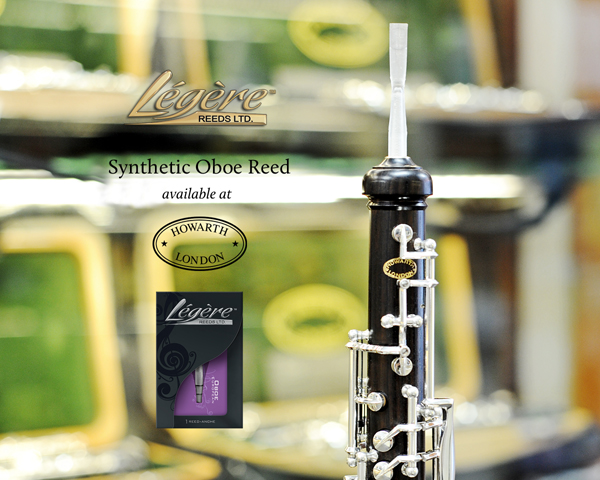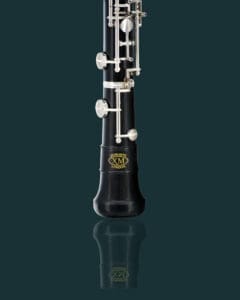Légère Oboe Reeds

Would you like to own an oboe reed which lasts for months, never requires soaking or adjusting, and consistently delivers excellent results? If so, you may like to try a synthetic Legere oboe reed.
Designed by Guy Légère in collaboration with Christoph Hartmann of the Berlin Philharmonic, Légère ‘soboe reeds have been tested by first-class musicians worldwide to ensure they are of excellent quality. An amateur clarinettist himself, Mr. Légère graduated in 1995 with a PhD in Chemistry and runs his reed production company from Ontario, Canada.
Whilst Légère reeds for clarinet and saxophone have been popular among leading classical and jazz performers for years, Légère oboe reeds are a more recent development, and the European scrape is now available in three strengths: medium soft (green ring), medium (yellow ring), and medium hard (blue ring), the softer strength Légère reeds requiring a more relaxed playing embouchure than the harder strengths. As with cane oboe reeds, choosing the most suitable reed strength for your playing is highly personal and differs greatly between players. Although some oboists require some time to become accustomed to the different sensation of playing synthetic reeds, others need no adjustment period at all.
Légère reeds are made using CNC (computer numerical control) cutting machines, out of a unique polymer compound. Whilst details of the exact material used by the Légère company to make their reeds are protected, the company assure that the polypropylene they use is completely BPA-free. The computer-controlled nature of the production process allows for an extremely high level of precision and quality control. The designs for the Légère double reeds were developed from a mathematical basis rather than a particular model of reed, an approach which the company claims results in ‘a reed which is perfectly balanced in both blades, and has just the right combination of tip thickness, heart, and flexibility’ (Légère Reeds).
Légère reeds are designed to fulfil the same expectations that players expect from their traditional cane reeds, including having a full, rich tone which projects easily. However, they additionally benefit from: having no need for pre-soaking, and being unaffected by variants in weather, leading to a higher level of consistency. The only variations one should expect between Légère oboe reeds of the same strength are slight differences in tone and level of projection, factors which will also be influenced by the individual player’s embouchure and instrument. The reeds are designed to be responsive, whilst maintaining stability in terms of intonation (playing at 440-442 Hz depending on their positioning in the oboe’s reed socket).
Another huge benefit of purchasing a synthetic Légère oboe reed is cost effectiveness. Despite being an investment initially at £137 each*, with appropriate care they can last for months, the exact length of time depending both on the reed’s strength and how often it is used. Although synthetic reeds can still be broken if mishandled or mistreated, they are more durable and less fragile than cane reeds and require little maintenance, allowing the player more time to commit to music-making. The oboist is only required to periodically clean their Légère reed with water, and to remove any debris from it with a small feather or similar material.
Légère oboe reeds are designed to provide an ideal ‘middle-ground’ which will suit the requirements of any oboist, e.g. in terms of response (they feel flexible to play whilst having some resistance), and tone (the sound is not designed to be particularly ‘bright’ or ‘dark’). However, the reeds can be adjusted to fulfil personal requirements, although this is certainly not necessary, and only recommended if you are highly adept at reed-adjusting. If you do decide to adjust your Légère reed, players may find it beneficial to clip a very small length of the tip of the reed or to slightly scrape the reed’s heart. Whilst not expected, if you find that your Légère reed is not completely airtight, this can be remedied by wrapping cling film or goldbeater’s skin around it in the same way as you would treat a cane reed.
In my opinion, it is always useful to have a Légère oboe reed in your reed case to provide you with peace of mind during performances. If you find whilst playing that your cane reeds are being adversely affected by weather/environmental conditions, having a Légère reed to hand ensures that you have a reliable alternative should you need one, which will work in a predictable and consistent way. I find that Légère oboe reeds are particularly useful if you do a lot of ensemble playing or are a doubler, as you can be more confident of a Légère reed’s response when coming in on an instrumental entry without having played the instrument for a while. Because Légère reeds wear down far less quickly than cane reeds, using them regularly for practice can help you build up your stamina and strengthen your embouchure.
A Légère oboe reed is certainly a worthwhile investment whether you are exclusively transferring onto them from cane oboe reeds or using them as an alternative option. Considering factors such as their consistency, durability, and reliability, it is easy to see why they have gained popularity amongst leading oboists internationally. Come and try them now in our London showrooms, or order one online on our website.
* Price correct at time of print. Legere reeds are supplied in sealed packaging and we cannot accept any returns. We have tester boxes of the different strengths in our shop so customer can determine which strength reeds suit their playing, but the stock reeds must be purchased before being removed from the packaging. Legere cor anglais reeds are currently in pre-production.
Bethany Craft, Oboe Specialist – Howarth of London
